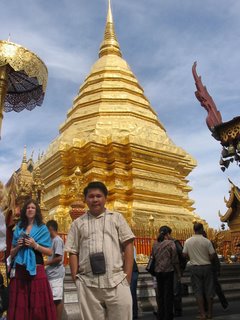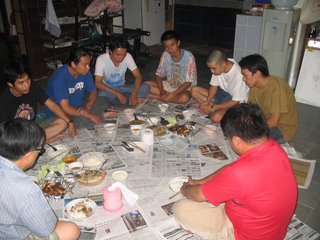Reflections: Learning from people in the Thai - Burma border




In October 2005, I spent around a month of fellowship with Shan people from Burma exiled in the northern Thailand city of Chiang Mai (CM). It was a month of learning and realizations. A trip to a South East Asian country gave me an exposure to international issues such as Myanmar.
My role would be to help Saengjuent, an intern from the CM-based Shan Herald Agency for News (SHAN) to apply or at least help process the things he learned from MindaNews when he went to Davao City in August 2005. The SHAN director, Khuen Sai, (middle, 2nd photo) asked me to help him train the younger members of their news agency on news writing.
I had four students in the workshop each of them played different roles in the agency. There is Arn Tai ("Ahn Tie"), the most senior who writes news in Thai language. There's Harn Mueng ("Hahn Moong") the translator to English from Shan language. The guy who writes Shan language news is Noom Korn ("Noom Kohn") and the agency's internet guy "Muengjuent".
They were a bunch of young and telented Shan news workers, very much eager to learn.
If we have no classes and meetings, they would encourage me to go out of town and explore the countryside. I spent time visiting areas where SHAN have contacts with communities. They also brought me to tourist attractions in CM, like the Doi Suthep (as shown in the photos). That's a mountain resort ran by the Kingdom of Thailand. The Thai King spends his summer time there.
Thailand and Burma (Myanmar) are neighbors. I heard they had a love-hate relationship through centuries. Now, Burma is under a military regime. The Thai government is using moderate diplomacy towards the military junta: they have close economic ties but from time to time Thailand joins the international community in pressing Burma for democracy.
As a result of internal hostilities between Burma and several rebel groups from ethnic states of Myanmar, hundreds of thousands of refugees fled the country and find their way along the Thai-Burma border through the years. The border is closed to passage in most points, but still a big number of refugees cross, largely in Northern Thailand via undisclosed routes.
The Thai government has designated "refugee camps" in selected areas. However, they are not refugee camps, based on international standards, as used by refugee groups.
According to some sources in the camps, the refugees from Burma's states are considered by the Thai government as economic migrants, not as refugees. Apparently, they lack support for livelihood inside small camps and have to look for informal jobs in proximate Thai towns along the border without identity.
I talked to many of these "migrants" in the camps I visited, I visited three but allowed entry only to two: in an area near Piang Luang and in an area north of Fang. They told me stories of violence, persecution, rape, extreme poverty and "culture of fear" in their homelands under the strong hands of the military.
I would have wanted to enter the third camp, near Mae Hong Son, which is a tourist city where you could see Kareni women shown to tourists like a "human zoo" as they are sometimes called. If you could remember photos of women with very long necks clad with some kind of a neck apparel, that's it.
I did not enter that "tourist spot". I agreed with my Filipina colleague in the internship program, I don't want to add to their "commercialization" even if I know that they have consented the attention.
Back to the third camp. I could not enter because journalists are barred from entering these camp. Our guide, Si Moon, who works with a Shan NGO in the area, brought us to a quasi-camp, just beside the no-journalist refugee camp.
I was told that it would be dangerous for journalists to come in because the Thai authorities would make it difficult "for you". I have insisted on a more logical explanation, but shut my mouth when my hosts showed some reluctance. It did not insist at all. What are they hiding there?
Well, we entered the "quasi-camp", called as it is for a number of reasons. I could remember perhaps two: one, although I'm not very sure about it this time -- that's where candidates for political asylum live; and two, that's where the disabled were taken cared of.
In that quasi-camp, I met and heard the sad but brave stories of the ex-soldiers in the first photo. Oo Reh (right) and Saw Teru (left) both 35 when I met them on 18 October 2005 along the Thai-Burma border near Mae Hong Son, (eight hours drive from Chiang Mai). Chiang Mai is almost two hours away by plane north of Bangkok.
Both of them are victims of landmines planted by the Burmese military and also by their own army. Oo lost his arms and one eye. Saw lost his sight. They both admitted ignorance about landmines when their commanders ordered them to clear their way of the mines.
In the Burmese war zones, military leaders, according to the two victims, use forced labor to clear areas from landmines. Many innocent people died because of these 'illegal' war weapon.
As we spoke, I hesitated to continue interviewing them because our presence and our questions seemed to have opened wounds that were about to heal from their tragic past. Oo expressed deep sadness of missing his family across the border. Saw said he did not know if his parents are still alive in Daw Tau Ka a village across Mae Hong Son, where landmine exploded and injured him.
But Saw also corrected us. He said their wounds won't heal anymore. "If you see us in pain, there is not much we can do to take away that experience from us". He said he also could not help from being "sad" about his ordeal. Instead, he appealed for journalists to help them help others. "There should be no more additional victims of landmines," he said.
"Please write about us. Please tell them to remove all the mines around the world," he said. "You do not know how painful it is. It is not like a bullet that could kill you in an instant. This one we bring all our lives. It has to stop!" (Oo and Saw spoke in Kareni and Burmese, while Si Moon translated it for us.)
It was indeed a depressing moment. I know the situation has not improved across the border. Both of them and tens or perhaps hundred of thousands more had been displaced from their homes because of hostilities and continuing tension between military forces of the Burmese junta and the rebel groups.
But I know I was there for a reason. I remembered both Oo Reh and Saw Teru when I came face to face with Myanmar's tourism minister who told the press during the ASEAN Tourism Forum in Davao City in January 2006 that there is peace in Myanmar and that people there are happy.
Both victims, like the good soldiers that they said they are, also told us also about the things that make them happy. Saw listens to music while Oo finds time interacting with the other residents in the camp. Both are taken cared by a small foundation helping victims of landmines across the border.
It was indeed a learning experience for me. It made me resolve to become a journalist who works for peace and to give voice to those who find themselves ignored. I saw and felt no difference between these people and those I met back in Mindanao who had been continuously plaged with evacuation, hostilities and poverty too. All of these are problems of human insecurity, prevalent everywhere.
When my Shan friends gave me a unique send-off dinner, where we squatted around spicy and exotic Shan and Thai food, in Chiang Mai on 21 October 2005; I felt the camaraderie among neighbors refreshed in my mind. I might have entered a "collective" that is different from mine because of cultural, historical, racial, economic and other divides; still I think we just belong to one neighborhood in Asia. I still think there are more similarities than differences.
Asians are divided in many respects, but are common in many things too. That trip made me see further, beyond my constructs of myself and the world. It opened my eyes to an interconnected world where there are local manifestation of global problems. And perhaps, local solutions too that have bearing across borders.
(The internship program was sponsored by the South East Asia Press Alliance or SEAPA based in Bangkok, Thailand)


0 Comments:
Post a Comment
Subscribe to Post Comments [Atom]
<< Home